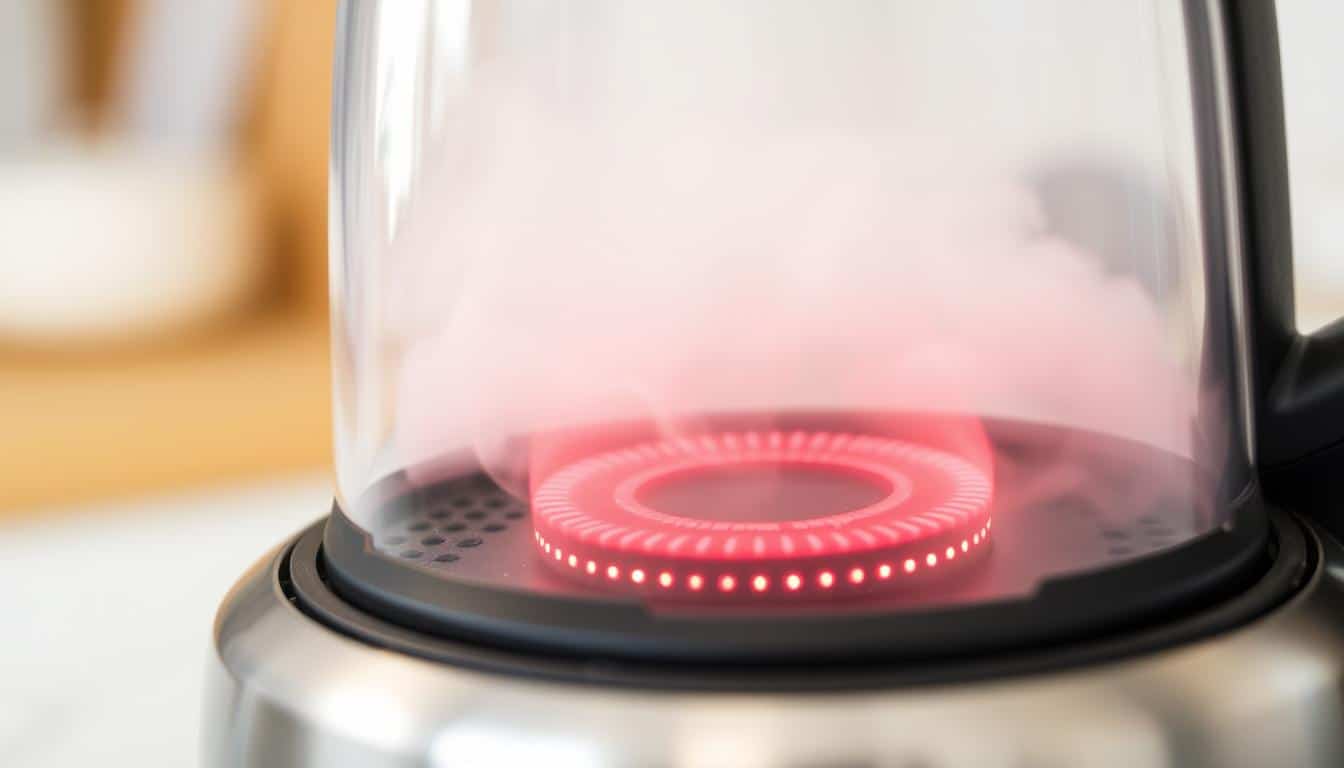What is a Heating Element? Definition & Purpose
In 2016, almost 40% of the world’s energy was used by the construction industry. It also caused 33% of the world’s greenhouse gas emissions1. These numbers show us how crucial efficient temperature control is. It helps reduce energy use and protect the environment. Heating components are vital here because they make heat in things like ovens and water heaters.
What is a heating element? It’s a part that changes energy into heat. This is important for gadgets at home and in big factories. Knowing about heating elements can help you use less energy. It also makes tech work better for us.
Key Takeaways
- A heating element is essential for generating heat in various devices.
- Heating elements utilize different energy sources, including electricity and gas.
- Temperature regulation is vital for energy efficiency in homes and industries.
- Understanding heating elements can lead to better energy management in daily life.
- Heating components are found in many common appliances, enhancing convenience.
Understanding the Basics of Heating Elements
Heating elements are key in turning energy into heat. They help you understand how these parts are made, the materials used, and how they work. Most use conductive, resistive, or radiant heating. These methods fit different needs in homes and industries.
It’s important to know the different types of heating elements. This knowledge helps when you need to pick the right one for your use. There are various types, each made for certain uses.
| Type of Heating Element | Application | Benefits |
|---|---|---|
| Resistive Heaters | Home heating systems | Cost-effective and efficient |
| Conduction Heaters | Industrial machinery | Fast heat transfer |
| Radiant Heaters | Heating large spaces | Even heat distribution |
Understanding these basics helps in making smart heating choices. When you choose carefully, your heating solutions will be more efficient and safe. This ensures great performance in various settings2.
What is a Heating Element?
A heating element turns energy, usually electricity, into heat. It’s a key part in devices from kitchen appliances to big machines. We’ll look into how heating elements work and the types you can find out there.
Definition and Functionality
A heating element changes electrical energy into heat. This happens because the element’s material resists the electric current, causing it to warm up. Then, it heats air, water, or solids. This process is vital in many devices that keep us warm or cook our food.
Types of Heating Elements
Different heating elements suit different jobs. Knowing the types helps pick the right one for your task. Below are some common ones:
- Resistive Wire Coils – Great for toasters and stoves.
- Ceramic Heating Elements – Perfect for high-heat needs.
- Metal Alloy Components – Chosen for tough industrial use.
Each kind offers special benefits like better efficiency or heat spread. Knowing these helps in chose the best heating element. This ensures your device works well and lasts long3.
How Heating Components Work
Heating components play a key role in making heat. These elements, especially electrical resistance heaters, are vital. Knowing how they work helps use them well and safely.
Electrical Resistance Heaters
Electrical resistance heaters turn electricity into heat through resistance. This happens when electrical current flows through a resistant material, creating heat. Because of their dependability, these heaters are chosen for many heating needs.
Heat Generation Process
The way these heaters make heat is important for their effectiveness. Their performance hinges on the material used, their design, and how they’re operated. Understanding this prevents overheating, ensuring they last longer and stay safe. Knowing about this heat-making process is key to safe and efficient heating applications1.
Applications of Heating Elements
Heating elements are crucial in many areas, affecting daily life and industrial activities. Knowing how they’re used helps us grasp their importance.
Common Household Devices
Inside your home, heating elements are part of many devices. For example:
- Toasters use heating elements to brown bread.
- Electric kettles feature heating elements to boil water quickly.
- Dryers employ heating elements to dry fabrics efficiently.
Industrial Uses
Outside the home, heating elements are vital in industries. They help in processes needing accurate temperature settings. Here are some instances:
- Metal working uses heating elements for proper metal shaping.
- Food processing depends on heating elements to cook and pasteurize.
- Pharmaceutical manufacturing uses them for sterilizing and chemical processes.
Exploring these uses shows the wide-ranging significance of heating elements. They boost efficiency and show how technology moves forward in everyday tasks and professional fields.
Types of Heating Elements Explained
To choose the best heating system for your needs, it’s crucial to know the different types of heating elements. Each kind offers specific features and benefits for various heating tasks.
Heating Coils
Heating coils are crucial in many electric devices like stoves and water heaters. These heating coils emit heat efficiently, perfect for cooking and warming spaces. They can quickly change temperatures, making them handy for users.
Immersion Heaters
Immersion heaters work by being placed directly in the liquid they heat, usually water. They’re found in many places, from homes to big factories. Their quick heating of fluids makes them a favorite for many jobs.
Baseboard Heaters
Baseboard heaters are crucial for warming rooms. They’re installed around room edges and use convection to spread warm air evenly. Knowing these types of heating elements helps you pick the best one for your heating requirements.
| Type of Heating Element | Common Uses | Efficiency |
|---|---|---|
| Heating Coils | Electric stoves, water heaters | High |
| Immersion Heaters | Water heaters, industrial processes | Very High |
| Baseboard Heaters | Residential space heating | Moderate |
The Role of Thermal Energy Generators
Thermal energy generators are a key part of today’s energy systems. They act as important heating components. They change energy sources into useful thermal energy. This function is crucial in power plants for converting fuels into heat to make electricity. Various thermal energy generators exist, aiding in everything from making electricity to direct heating.
Knowing how these generators work shows their role in homes and industries. Advanced thermal energy generators make industries more energy-efficient. For example, incorporating these systems can greatly increase efficiency in using energy, helping in sustainability.
These generators can adjust to different demands and energy sources. Their flexibility makes our energy system more robust. It can meet changing energy needs in various places5.
Temperature Control Devices and Their Importance
Temperature control devices are key in modern heating systems. They help keep appliances safe and working well. This includes thermostats, sensors, and controllers that keep an eye on and adjust the heat. These systems stop overheating and lower fire risks and injuries. Recalls have happened with heated seats from brands like Mazda, Toyota, and BMW. This shows why checking these parts regularly for safety and efficiency is crucial to maintain optimal performance1.
Understanding how different temperature control devices work together is important. A smart system cuts down on wasted energy. This helps our planet while keeping you comfortable. If not looked after, these devices can become dangerous. This highlights the need for regular checks and upkeep.
Understanding Radiant Heating Systems
Radiant heating systems are gaining popularity for their effective warmth. They transfer heat directly from warm surfaces to objects and people nearby. This method reduces air movement, offering a comfortable, draft-free environment. Many are choosing radiant heat for floor and wall installations because of its efficiency and coziness.
These systems are known for their energy-saving qualities. Companies like Rixen’s Enterprises have designed heating solutions for spaces from RVs to boats. Their airtronic units, with heat output ranging from 7,500 to 18,800 BTU, meet diverse HVAC needs6.
Furthermore, radiant heating eliminates cold areas, making it perfect for rooms like bathrooms. Geothermal floors provide consistent warmth, making winters more comfortable7. Smart technology, such as smart showers and heated toilets, enhances the experience by allowing for custom settings. This technology boosts the attractiveness of radiant heating.
For those valuing comfort and wellness, radiant heating offers more than just warmth. It includes benefits for circulation and relaxation. As awareness of these benefits grows, radiant heating technologies are set to become a key part of modern living solutions7.
Heat Exchangers in Heating Applications
Heat exchangers are key in many heating tasks. They make sure heat moves well from one fluid to another. These devices keep the fluids from mixing and help save energy in systems like heating for RVs. Sprinter/Class B & C RV systems, for instance, have airtronic units with power ranging from 7,500 to 18,800 BTU6. Similarly, hydronic systems show their flexibility with capacities between 8,200 to 17,100 BTU6.
Heat exchangers are great at using waste heat wisely. Take the ConstaHot system, it gives you water at 106 degrees Fahrenheit with a flow of 2.5 GPM. This means you always have hot water ready6. It shows how these systems meet our needs today by focusing on being green and efficient.
Also, heat exchangers can work with diesel or electric power, showing they fit various settings. Diesel heaters can pump out up to 120,000 BTU. They work well in both RVs and boats6. By using heat exchangers, machines work better and cost less to run, making a big difference for users.
Benefits of Using Heating Elements in Modern Technology
Heating elements are becoming increasingly essential in today’s tech scene. They offer significant benefits across a range of uses. These include improving performance and offering advantages for both individual consumers and entire industries.
Efficiency in Temperature Control
Efficiency in temperature control stands out in modern heating elements. They make fine tuning temperatures easy, reducing wasted energy. This not only cuts costs but is especially valuable for industries needing precise temperature control for their processes.
Durability and Longevity
Heating elements’ durability and longevity also matter a lot. Thanks to better materials and design, they can handle tough conditions without losing efficiency. This lowers the need for frequent replacements, offering a more reliable solution for those investing in heating technologies.
| Benefits | Details |
|---|---|
| Efficiency in Temperature Control | Minimized energy wastage, resulting in significant cost savings. |
| Durability | Long-lasting performance under various operating conditions. |
| Longevity | Reduced need for replacements, ensuring reliability. |
Common Issues with Heating Elements
Heating elements are key in many devices, but they can run into problems affecting safety and performance. One big issue is burnout. This happens when they are used too much or with bad voltage control. Regular checks can catch this problem early.
Not heating up enough is another common problem. It can happen due to weak connections or a bad thermostat. Checking the heating components‘ wiring to make sure everything is connected properly is crucial.
Corrosion is yet another issue that can impact heating elements. Things like humidity can harm the metal parts, making them less efficient and more likely to fail. Doing regular maintenance to check for wear and corrosion helps avoid these problems. Knowing about these issues is key to keep heating systems working safely and well.
Overheating is a serious issue too. It’s been a problem in cars like the Mazda CX-9 and the Cadillac CTS. Faulty heating elements in these vehicles have caused fires. These dangerous situations need quick fixing94.
Choosing the Right Heating Element for Your Needs
When picking the perfect heating element, think about your needs. Consider the needed temperature, energy sources, and space. Since heating elements have different uses, knowing these details is key.
Efficiency ratings of heating components also matter a lot. They help decide which one to choose. Also, think about if it fits with what you already have. This saves money and makes integration smoother. Researching well avoids problems later on.
Looking for the right heating element means exploring many options. For quick heating and easy care, a Prestige 800W Sandwich Maker is smart due to its non-stick feature10. If you like cooking the old-fashioned way, consider the Tosaa Non-stick Grill Sandwich Toaster. It works without power10.
It’s important to look at the machines themselves too. The iBELL SM1515 Sandwich Maker adapts to different bread sizes with its adjustable hinges10. This versatility is crucial for businesses needing dependable heating.
Below is a comparison table to help understand the differences between popular sandwich makers:
| Sandwich Maker | Price | Wattage | Material | Special Features |
|---|---|---|---|---|
| Prestige 800W Sandwich Maker | ₹949 | 800W | Plastic | Non-stick coating, oil-free toasting |
| Tosaa Non-stick Grill Sandwich Toaster | ₹278 | – | Aluminium | Gas-compatible, non-electric |
| iBELL SM1515 Sandwich Maker | ₹1,393 | 1000W | Metal | Adjustable floating hinges, versatile design |
Conclusion
Heating elements are vital in many areas of modern technology. They meet both home and industrial needs. Knowing about heating elements helps us understand how they work. This shows their key role in making heating efficient and effective.
These components are crucial for everything from geothermal heating to smart tech. They improve comfort and use.
Heating elements are now used in new ways, like smart showers and heated floors. This saves energy7. They’re key to making heating systems better, lowering energy use. This is important for a better climate. Using better heating can change construction and homes greatly1.
To make the most of heating elements, know the different types and their perks. By choosing wisely, you can use their power for your heating needs. This makes living spaces more sustainable and comfy11.







